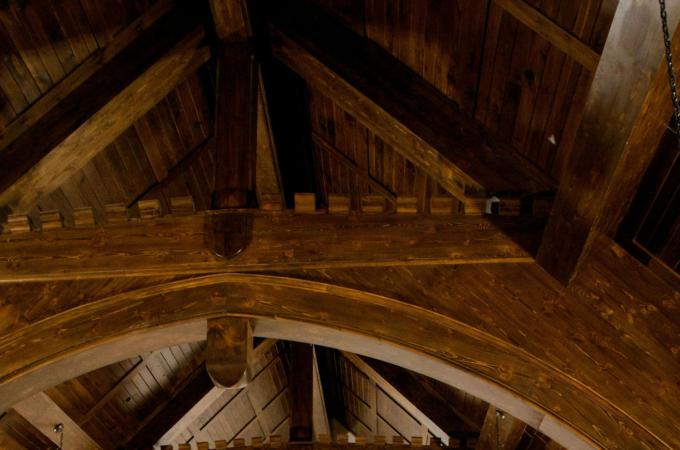Form follows spirit in new Seaport Shrine
SOUTH BOSTON -- A decade ago, Boston's Seaport district looked more like an industrial lot than an inhabited part of the city. Today, the Seaport district is under bristling with construction.
Gone are the under-used lots, their asphalt cracking from years of neglect. In their stead is a series of high rise building in various stages of construction. And in the heart of it all sits a newly built church: Our Lady of Good Voyage Shrine.
In the days before the shrine's April 22 dedication, Father Jonathan Gaspar, priest secretary to Cardinal Seán P. O'Malley and Director of the Office of Divine Worship for the Archdiocese of Boston, gave The Pilot a special preview of the chapel.
"Really, the location of the chapel is the first thing that stands out," Father Gaspar said, noting that since the church is located at the corner of Sleeper Street and Seaport Blvd., "as soon as one crosses over the bridge (from downtown), our chapel is there, as the gateway into the Seaport District."
According to Father Gaspar, the design of the building was largely dictated by Cardinal O'Malley's aesthetic.
"The cardinal preferred a more traditional design, and so this church is built in the English Gothic Revival style," he said.
Father Gaspar also noted that everything in the chapel -- from its stained glass windows to the ceiling to the sanctuary flooring -- "is not just functional, but symbolic."
Because of the longstanding maritime history of Boston's waterfront, as well as the rich nautical symbolism of Christianity, the chapel is built with a nautical flair.
The chapel's 24-inch brass bell, commissioned from the Verdin Bell Company in Cincinnati, Ohio, "sounds like a ship's bell," noted Father Gaspar. Anchors accentuate the chapel's wooden entry doors and mooring rings are used in place of traditional handles.
Once inside the chapel, the lancet windows in the vestibule feature St. Peter, patron saint of fishermen, as well as Our Lady of Good Voyage, patroness of the shrine. Both Cardinal O'Malley's coat of arms and Pope Francis' coat of arms complete the Lancet windows.
"Even the vestibule has its function and symbolism," explained Father Gaspar. "The vestibule is really the passage between the world outside and Christ. We leave behind the noise and enter into the silence within."
Before entering the chapel itself, there is a small shrine which houses a statue of Our Lady of Good Voyage. According to Father Gaspar, the former Our Lady of Good Voyage Seaport Chapel once held a similar statue that had been gifted by a parish of the same name in Gloucester.
"Unfortunately, after years of sea breezes, that statue had deteriorated and was unrestorable," he said.
The new one was built in a studio in Oberammergau, a small German town nestled in the Alps, famed for its wood carving.
"We sent them an image of the original Our Lady of Good Voyage figure that is in the parish in Gloucester," Father Gaspar said. "Based on this image, they created this magnificent statue."
Inside the nave of the church, the ceiling is built to look like a ship.
"Traditionally, shipbuilders were commissioned to build church ceilings because the nave of a church is meant to signify a boat that guides us on our journey to God," explained Father Gaspar, noting that the word "nave" is derived from the same root as "naval" or "navigate."
"Even the vents inside this nave are meant to look like portholes," Father Gaspar added.
Hanging from the ceiling along both sides of the nave are model ships, each a different type of vessel, but all integrally a part of the maritime history of Boston.
Written above the windows is a passage of Psalm 107, which reads, "They that go down to the sea in ships, that do business in great waters; These see the works of the Lord, and his wonders in the deep."
"This scriptural reference is not just for those who work in the seas, because God is the one who calms the seas -- not just the physical seas, but also the seas of our lives, of our situations," Father Gaspar said, adding that "Everything you see has a meaning and a significance. There is nothing anywhere in this chapel that is not filled with meaning."
Father Gaspar noted that many of the items within the church have been repurposed from closed church buildings. The stained glass windows that line the right side of the chapel are from Holy Trinity Church in the South End, as are the pews, the chandeliers and the front altar. To the left of the chapel, the stained glass windows originally came from Our Lady of the Assumption Church in Chelsea. The center of the rose window above the choir loft comes from St. Augustine Church in South Boston. The Stations of the Cross are from Regis College Convent Chapel. The wood detailing in front of the choir loft are from Our Lady of Victories Church in the Back Bay.
"As much as possible, we tried to keep all the names of those who donated these magnificent windows," Father Gaspar said. "That way we could honor their memory in their new home."



















